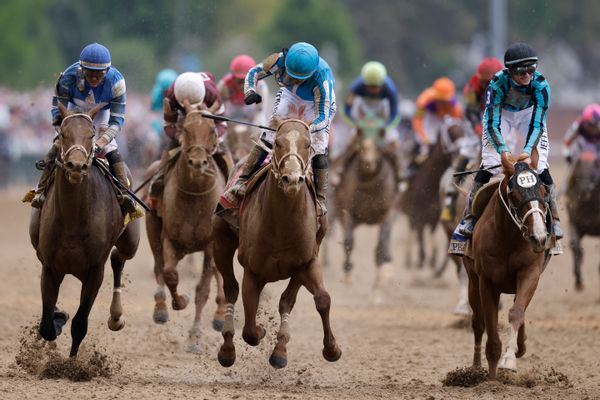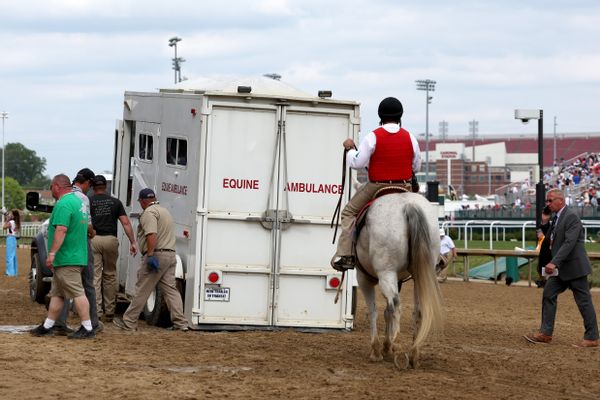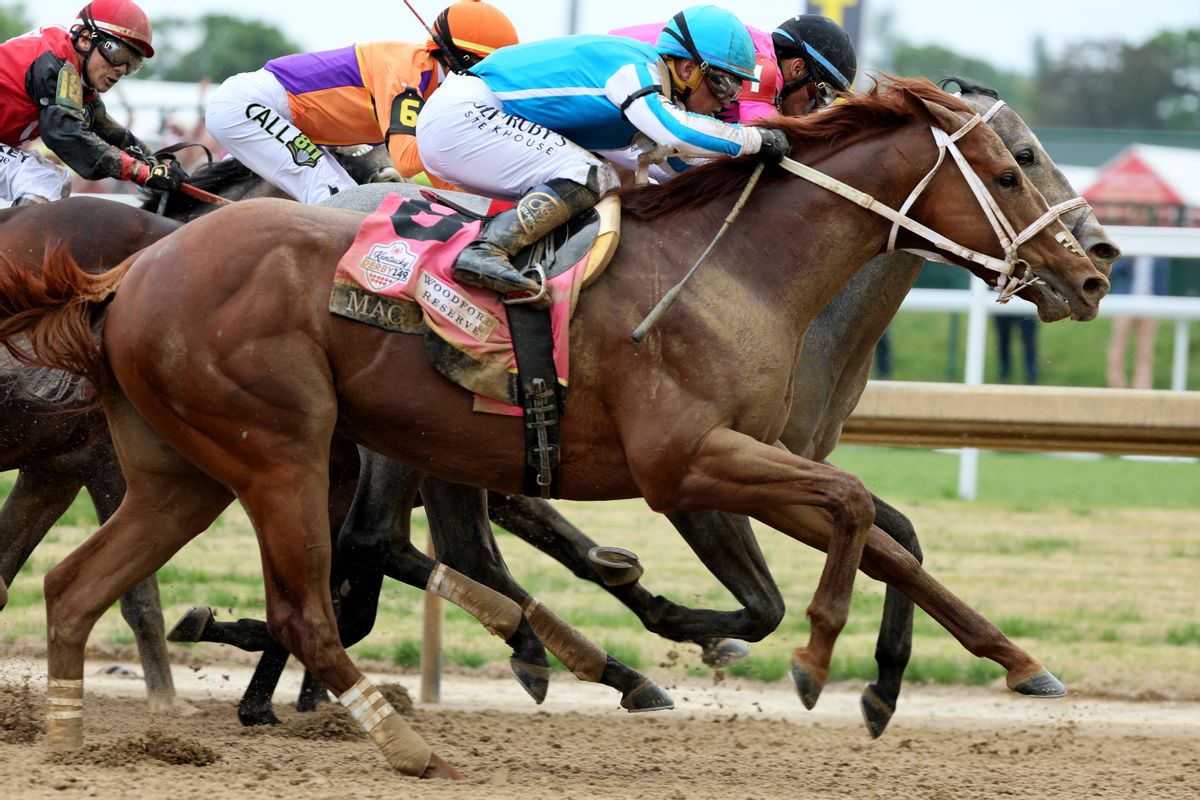Twelve horses have died at Louisville, Kentucky's Churchill Downs since April 12, 2023. As of this writing, 16 have died at Belmont Park — where the Belmont Stakes, the third and final jewel of the Triple Crown, is set to take place on Saturday, June 10. And every time another beautiful horse with terrible odds dies brutally in the dirt, bit-choked and lungs bleeding out, Americans ask "Why?"
At peak racing speed, they can thunder through the turns of Churchill Downs at 38 miles per hour. The sheer force of their thousand-pound bodies pummels the dirt track's hazardous slings — but only after first funneling through the narrow cabling of their spindly forelimb ligaments. Unrelenting propulsion ripping through channels of deep flexor tendons and shock-absorbing fetlock ankles, every ounce of a thoroughbred racehorse's weight is condensed into aluminum-shod hooves, bred so thin and small they average just four inches across.
Though most thoroughbred hearts are between eight and 10 lbs, the legendary Secretariat had a heart that weighed 22 lbs. The bigger the heart, the faster the horse — and the more they race in early age, the bigger their hearts will grow. A yearling's heart is a quickly shifting landscape, its cardiac morphology sensitive to both the rigors of endurance training and long-known diseases of overbreeding. A foal's heart can grow anywhere from 10% to 33% in size under the sting of a trainer's crop.
It is then — in those moment of racing fury, when a horse's every capillary is flushed wide in a 250-beat-per-minute frenzy — that a flood of pharmaceuticals meets the arterial gasp of oft-leaking valves, sending lethal numbness crashing through the animal's veins. Some drugs are perfectly legal, some are unseen by blind-eyes turned, some are new enough they don't show up in tests. Either way, the dope madness takes a thoroughbred deeper into its race, carried by a heart that was bred too big for life outside the track.
Want more health and science stories in your inbox? Subscribe to Salon's weekly newsletter The Vulgar Scientist.
We've always known why
At least, any of us who've grown up around Kentucky's horse country have known what kills horses. It's not a mysterious plague, nor an act of a merciless god. We're the ones killing racehorses — humans.
Specifically, the inhumane horsemen who trade their husbandry ethics for a purse, and so blight what was once called the sport of kings — ruthless trainers, greedy horse owners, shady veterinarians and track executives, paid-off sporting regulators, lawmakers greased with lobbying money and judges who slow-walk already watered-down safety laws. Humans are killing racehorses in any way that will increase profit and reduce cost, however the law will allow.
We overbreed them for fleetness at the cost of hardiness, run them far too young at punishing speeds on poorly surfaced tracks and dope them until they can't feel the lacework of fractures sprawling across their lightweight bones nor the arrest seizing their engorged hearts. And when they fall, rather than be inconvenienced by expensive medical treatment and unprofitable recovery time, we kill them.
The particulars of the doping-related deaths change over the years, a game of Whac-a-Mole between sporting regulators (those not bought off) and black-market poison dealers.
We used to inject horses with cobra venom, sometimes venom from south American frogs. Both kill the nerve endings while the latter gets the horse high. Then, for a while, it was Viagra. We even get the fillies jacked up on Bolivian marching powder, cutting cocaine with whatever brings urine test results under legally allowable limits.
There are three main types of racehorse dope: the painkillers and steroids to keep them from slowing down; the stimulants and blood-oxygen boosters to speed them up; and the stop-gaps to hide injuries caused by the first two.
Readily available for purchase online — and often advertised with the blaring slogan "WILL NOT TEST!" — new versions of all three types of drugs appear every year on a gray market that moves faster than regulators and test-makers, mirroring the cat-and-mouse charade of the human War on Drugs. The shady horse drug industry found its best advantage in what was, until recently, a patchwork of laws across 38 states, enforced by often understaffed and underfunded local agencies.
We knew the 2023 Kentucky Derby could be lethal
 Jockey Javier Castellano rides Mage #8 to a win in the 149th running of the Kentucky Derby at Churchill Downs on May 06, 2023 in Louisville, Kentucky. (Joe Robbins/Icon Sportswire via Getty Images)
Jockey Javier Castellano rides Mage #8 to a win in the 149th running of the Kentucky Derby at Churchill Downs on May 06, 2023 in Louisville, Kentucky. (Joe Robbins/Icon Sportswire via Getty Images)
Take for example, the performance-enhancing drug known as Lasix (also called furosemide, a potent diuretic that prevents exercise-induced pulmonary hemorrhage, which is bleeding in the lungs.) Lasix was perfectly legal and routinely used by trainers until 2021 — but, even then, the law barring it still allowed a phase-out exemption. Churchill Downs voluntarily banned the drug from stakes races in 2021, but the law itself came into the world at the same time as the Horseracing Integrity and Safety Authority.
HISA is a federal oversight body, with accompanying reform act, finally created by Congress to reduce the absurd number of yearly horse deaths after the FBI brought down a 27-member horse doping ring in 2020. HISA, however, was buried in lawsuits from the start, slowing it's ability to do anything about doping until May 22 of this year — after the 2023 Kentucky Derby and Preakness.
It's worth noting that Kentucky Derby horses are never more than 3 years old. Those that ran in 2023 would have been training and running while, in some cases, Lasix was still technically legal.
"It's apparent that there's more at
work here than track surface threats"
The lawsuits against HISA were largely spear-headed by the National Horsemen's Benevolent and Protective Association, which joined with several state affiliates to try and abolish the agency altogether. Their own former president, however, has long been on-record disclosing rampant doping, unchecked by local authorities.
"At a 2017 trial in a sweeping doping case, Stephanie Beattie, the former president of the Pennsylvania Horsemen's Benevolent and Protective Association, said up to 98% of race horses — including her own — were illegally drugged to block pain and increase performance," reported the Philadelphia Inquirer.
Then there are those like Mike Repole, co-owner of early Kentucky Derby favorite Forte. Repole told the Associated Press there were other ways to fix doping and injuries in the sport apart from the federal regulations of HISA.
"HISA can be part of the answer, but it's a spoke in the wheel. We always have to try to do more," he said.
But that was before Repole's horse, Forte, was scratched from this past May's Derby when a track veterinarian discovered bruises on his hoof. It was then discovered Forte had won four races since failing a drug test the previous September.
Judge James Wesley Hendrix of the U.S. District Court for the Northern District of Texas held HISA at bay for the NHBPA on March 31 of this year. He said it was more dangerous to the health of the horses if HISA rules kept them from racing.
"The plaintiffs have shown a serious risk of harm — potential physical injury to racehorses, potential disqualification from Triple Crown prep races, and the burden of coming into compliance with a new anti-doping regulatory scheme without the legally required delayed effective date," Hendrix said, per the Associated Press.
As if the lawsuits weren't enough to endanger HISA testing standards and delay implementation, HISA then parted ways with the U.S. Anti-Doping Agency on rule-making (though USADA will still act in an enforcement capacity). Finally, the Federal Trade Commission punted the implementation of the anti-doping rules until May 22 of this year which — as animal welfare advocate Marty Irby pointed out — would be weeks after the Derby.
If we find in coming months or years that any of the 12 dead at the Downs tested hot, then we can mark the FTC's ruling as the moment of fait accompli.
Loopholes, wrist-slaps, and revolving paddock doors
 An equine ambulance carrying race horse Here Mi Song is driven off the track after racing in the tenth race ahead of the 149th Kentucky Derby at Churchill Downs on May 06, 2023 in Louisville, Kentucky. (Rob Carr/Getty Images)Racing commissions in West Virginia and Oklahoma, along with the U.S. Trotting Association also filed a separate anti-HISA lawsuit in Kentucky, however. And, as reported by Reuters, Churchill Downs CEO Bill Carstanjen initially didn't want to see HISA pass. In 2019, he said the company had "serious concerns" about the HISA bill and did not think federal legislation was "practical, reasonable, or imminent."
An equine ambulance carrying race horse Here Mi Song is driven off the track after racing in the tenth race ahead of the 149th Kentucky Derby at Churchill Downs on May 06, 2023 in Louisville, Kentucky. (Rob Carr/Getty Images)Racing commissions in West Virginia and Oklahoma, along with the U.S. Trotting Association also filed a separate anti-HISA lawsuit in Kentucky, however. And, as reported by Reuters, Churchill Downs CEO Bill Carstanjen initially didn't want to see HISA pass. In 2019, he said the company had "serious concerns" about the HISA bill and did not think federal legislation was "practical, reasonable, or imminent."
"We have expressed those concerns to industry constituents and the bill's sponsor but they were never addressed," he said at the time.
Churchill Downs, however, changed its tune when one of racing's most infamous trainers, Bob Baffert, threw the track into a doping scandal in 2021 with his disqualified Derby winner Medina Spirit. Not long after, the bill secured greater support of Kentucky Republican Sen. Mitch McConnell.
12 deaths at his track later — 9 of which were on-track breakdowns — Carstanjen is now dealing with a HISA investigation.
It's also hard to prevent horse racing deaths when wrist-slap fines and mile-wide loopholes allow a revolving door of trainers to pass through the sport. Two of the 12 dead at the Downs, Parents Pride and Chasing Artie, were trained by Saffie Joseph Jr. Sure, he's been permanently suspended from Churchill Downs after the two deaths, but he was previously suspended in Pennsylvania and New Jersey for doping-related concerns. Meanwhile, Baffert will be allowed back on the track next year.
With HISA drug-testing standards having been delayed until after the Derby, and post-mortems revealing little, trainer doping suspicions have continued to swirl. Carstanjen announced on June 2 that races would temporarily move to Kentucky's Ellis Park so that Churchill Downs can join HISA — and the Kentucky Horse Racing Commission — in investigating the causes of the deaths.
Carstanjen indicated the investigation would look at the turf surface of the track, and said the company would "conduct a top-to-bottom review of all of the details and circumstances so that we can further strengthen our surface, safety and integrity protocols."
But HISA threw cold water on the turf question straight out of the gate.
"After conducting his own inspection of the surface and reviewing data collected by Racing Surfaces Testing Laboratory and Churchill Downs, [track surface expert Dennis Moore] reported there were no primary areas for concern and has verified that the various track metrics analyzed are consistent with previous years," the agency said in a statement.
As reported by the Louisville Courier Journal's Brooks Holton and Stephanie Kuzydym, people aren't buying the turf argument.
"It's apparent that there's more at work here than track surface threats," said Wayne Pacelle, president of Animal Wellness Action and the Center for a Humane Economy.
Pacelle wants Churchill to suspend racing "until there is a proper forensic analysis of the horse deaths and a comprehensive plan to remediate future deaths."
It's hard to tell how long that's going to take, though. The KHRC entered a voluntary agreement to enforce HISA's anti-doping rules in March of this year, but HISA also seems to have handed over the reins of the investigation to the KHRC.
"With these agreements in effect, the KHRC has authority to suspend a license for any violation that threatens the integrity of Kentucky horse racing or the KHRC's ability to protect the racing public," the KHRC said in a statement, "except where HISA has preempted state regulations in the areas of track safety, and anti-doping and medication control. If a track had violations related to either of these areas, HISA would have jurisdiction."
The fact that KHRC's last public doping report is from 2020 — while reports for 2021, 2022, and 2023 appear to be absent — offers little certainty about the transparency standards of the investigation. And, while federal HISA laws may override some of the state's statutes, the list of what you could get away with in Kentucky horse racing for the last few years is eye-popping. In some cases, a drug that might be otherwise wholly banned in other countries for the duration of a horse's career is banned for only a brief pre-race window in Kentucky.
While some novel element of tragedy may yet be discovered in the particulars of the 12 dead at Churchill Downs, there's no mystery in the near-identical racehorse deaths that have marred American tracks for years.
And on top of everything else, the state's mandated horse mortality reviews are designed to require so little detail that they shed almost no light on the actual causes of the death.
With closed-door meetings between track owners and regulatory bodies, wrist-slap fines and a legacy of lax doping rules in a multi-billion-dollar industry, discerning truth from formal investigative reports might never yield real answers about whether or not doping-related injuries are at the heart of the 12 deaths at Churchill Downs.
But we know doping causes these same types of injuries every day in tracks around the country. And their doctors have known longer than anyone.
"Every day, I almost quit," racehorse veterinarian Kate Papp told NBC News' Anna Schecter in 2014. "Every day, I decide I don't want to see 2-year-old [horses] that haven't even run yet be euthanized in a dirt pit at the back of the racetrack because somebody trained them too hard, medicated them too much, pushed them too far."
Pain-killers, anti-inflammatory drugs, cocaine and cobra venom — whatever it takes to keep the race going, keep the money coming. Splayed bone shards, shattered ankles, lungs full of blood — we rip them limb-from-limb. While some novel element of tragedy may yet be discovered in the particulars of the 12 dead at Churchill Downs, there's no mystery in the near-identical deaths that have marred American race tracks for years.
There's no more need to ask why. Whatever killed those 12 racehorses, it's the same cause of death it's always been. It's us.
Read more
about humankind and the animal kingdom



Shares